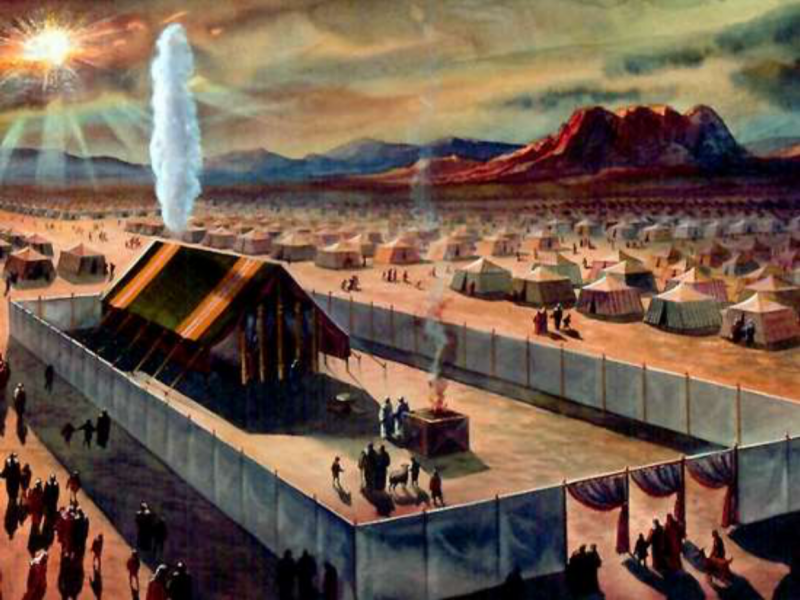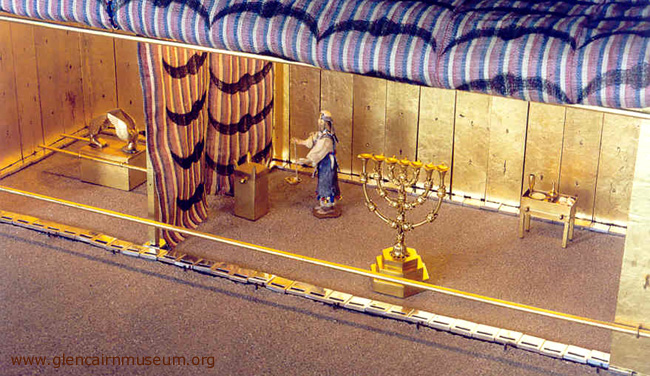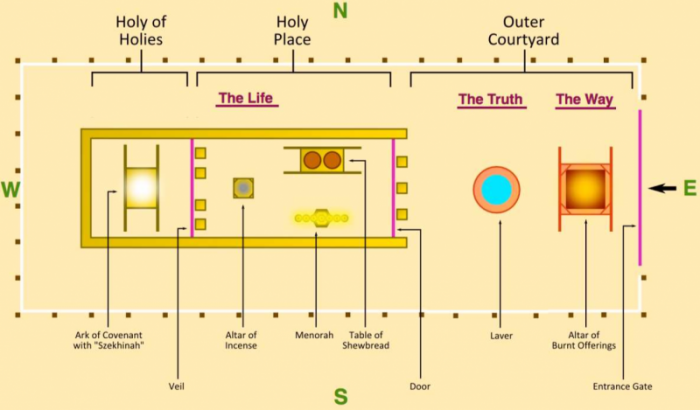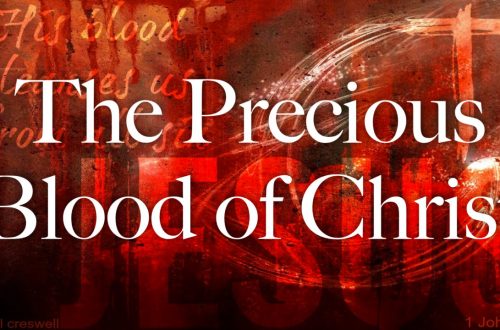
The Tabernacle of Moses – God’s Heavenly Pattern for our Spiritual Transformation – Part III: The Holy Place – Table of Showbread
THE TABLE OF SHOWBREAD
The Table of Showbread is located to our right along the Northside of the Tabernacle, directly across from and illuminated by the Golden Lampstand. Remember, there was no other source of light in the Holy Place other than the Golden Lampstand. The light from it is reflected off of the walls that are made of boards of acacia wood (very disease and pest resistant) overlaid with pure gold (Exodus 26:15-29) and the ceiling that is made of colored fine linen with pictures of the Cherubim (i.e., angels that guard God’s throne in Heaven) sewn on them (Exodus 26:1-6). Just as the Priests could not see the bread without the illumination of the Golden Lampstand – we can not see God’s provision for our lives without the illumination of the Holy Spirit.

The gold (1) overlaid wallboards are held together and kept from touching the Earth by a solid silver (1) block-like foundation at their base (Exodus 26:19). Pure gold represents the Holiness of God who cannot touch sin, silver represents the price paid for redemption (Numbers 18:16), and Earth (dirt) represents fallen man (2 Corinthians 4:7). Symbolically, this tells the story of our mediator Jesus the God-Man making way for the fallen man (dirt) to connect back to God the Father (pure gold) by becoming our payment for redemption (silver) (1 Timothy 2:5. Hebrews 9:15). It also represents that the foundation of our lives and the church is the redemptive work of Jesus Christ!
Well, if you have not seen it yet – the whole Tabernacle and surrounding structures are about JESUS! Would somebody say AMEN! OK, just had a holy fit (that would be a bene-fit)! Back to the Blog…

The table is made of acacia wood (1) and is overlaid with pure gold (Exodus 25:23-26). It has rings on each corner to insert the gold-covered acacia wood poles used to carry it. There are plates, bowls, pitchers, and cups all made of pure gold. Twelve small cakes (like tortillas) of unleavened bread were placed on it in two stacks of six each representing both Jews and Gentiles living in harmony (Leviticus 24:5-9). Also, there is one cake representing each of the twelve tribes of Israel and the future twelve Apostles of the Lamb. The cakes remained on the table for seven days and then are eaten by Aaron and his sons at the table, on the Sabbath, after they are replaced by fresh bread. Remember, the bread had to be eaten together with the other priests at the Table of Showbread in the Holy Place, for the bread was Holy. The solid gold plates were used for the cakes of bread. The solid gold bowls contained the frankincense sprinkled on the bread using sold gold spoons (Exodus 25:29). The solid gold pitcher and cups contain wine (Numbers 4:7).
Showbread literally means the bread that will cause God to “show up.” Symbolically, Jesus is our bread (our provision) that those that partake of will receive eternal life (John 6:35. John 6:47-51). The frankincense represents our prayers to God (Revelation 5:8). The wine is symbolic of blood representing life (1), and it was poured out as an offering (Leviticus 17:11. 1 Corinthians 11:25). Realize, the fire of God never falls unless there is a sacrifice of something costly (to the giver) on the altar. Furthermore, God measures your giving NOT by what you give but rather by what you withhold (Mark 12:41-44).
Therefore, the Table of Showbread contains the following message for us today: when we priests (again, all believers are called to be priests (Revelation 1:6)) come together in unity and prayer to partake of Jesus our one “Bread of Life” and pour out our lives as a sacrificial offering – then God will “show up” in our midst (Matthew 18:19,20. 1 Corinthians 10:17).
Furthermore, this table not only represents our union with Christ but our unity with others. The cakes are stacked six high and adjacent to one another. In the Bible, six is man’s number, representing mankind living in harmony (1 Corinthians 10:16,17). Whenever we come together in unified by prayer in Jesus’ name, then God’s oil, the Holy Spirit, will flow down from the Head of the church (i.e., Jesus) to the body (i.e., the church on Earth) (Psalms 133. Acts 4:24-31).
Realize, it is impossible to get along with one another consistently in the Church without the anointing of the Holy Spirit (Philippians 2:1-4). He is the oil that reduces the friction between fellow Christians. Regrettably, very few Christians in our churches today have the anointing that abides within released by God to come upon them. Figuratively, they are still outside the tabernacle admiring the Brazen Altar but not laying down their lives on it. No wonder we spend so much time devouring one another! (Galatians 5:15,16)
At the Brazen Altar, we identified with the suffering Jesus endured when He redeemed us at the cross of Calvary. This was suffering we could NOT endure for a price we could NOT pay (i.e., the price for our justification). However, at the Table of Showbread, we enter into a fellowship of Jesus’ suffering that we can and must learn to overcome (Philippians 3:10. 1 Peter 4:1. 1 Peter 2:21). It is suffering that will teach us to obey God no matter the circumstances and form the character of Christ in our lives (Isaiah 48:10. Hebrews 5:8;2:10,18;4:15.1 Peter 4:12-19). This suffering will be inversely proportional to our level of obedience. Realize, it is the love of God that compels him to “judge it right” for this suffering to come into our lives. He loves us too much to leave us in our fallen condition in light of the availability of having our character conformed to that of Jesus! (Romans 8:29-39)
However, this is not referring to self-imposed suffering based on unwise choices but rather suffering (Hebrews 2:18) that is divinely orchestrated to accomplish God’s purpose of making us like Jesus Christ in His obedience and character (i.e., the price for sanctification). Suffering is what is represented by the stale unleavened bread eaten with bitter frankincense upon it. It is the call to pick up your cross daily and deny yourself what the world is profusely offering – the temporary pleasures of sin (Hebrews 11:25. 1 John 2:16). It is at the table of Showbread that we die to our EMOTIONS leading us. That is, we learn to cause our emotions to follow our will and not vice-a-versa.
Summary:

In Phase I (1) (Brazen Altar and Bronze Laver (1)) of our spiritual journey, we began to know in whom we have believed (2 Timothy 1:12), leading to the renewing of our minds and experiencing of His power in Phase II (1) (Golden Lampstand (1)). Next, in Phase III (1) (Table of Showbread), so that our fallen nature and character might not use His power to our ruin, God passes judgment for suffering to come into our lives to shape our obedience and character into that of Christ (James 1:2-4) which includes the removal of pride (2 Corinthians 12:7). The group of believers that have experienced the power of God in Phase II and learned to “suffer effectively”(1) will begin the process of having their character changed into that of Christ Jesus over their lifetime as a Phase III Christian (Romans 5:3-5;8:29). That is, time at the Table of Showbread will change our character to be like Christ Jesus, inculcate a relational Christianity in our lives, and will learn obedience through the suffering. However, there is the final surrendering of our will ahead at the Golden Altar of Incense. Again, we identified with Jesus’ suffering and death at the Brazen Altar, participated in His sufferings at the Table of Showbread. Still, now we must participate in His death via the final death of our will until we realize that the only reason we live is to accomplish His will which is learned at the Golden Altar of Incense (Philippians 3:10. Hebrews 10:7. Philippians 1:21).
The Tabernacle of Moses Series:
- God’s Heavenly Pattern for our Spiritual Transformation – Part I: The Outer Court
- God’s Heavenly Pattern for our Spiritual Transformation – Part II: The Holy Place – Gold Lampstand
- God’s Heavenly Pattern for our Spiritual Transformation – Part III: The Holy Place – Table of Showbread
- God’s Heavenly Pattern for our Spiritual Transformation – Part IV: The Holy Place – Golden Altar of Incense
- God’s Heavenly Pattern for our Spiritual Transformation – Part V: The Most Holy Place
- God’s Heavenly Pattern for our Spiritual Transformation – Part VI: The Priestly Garments
- God’s Heavenly Pattern for our Spiritual Transformation – Part VII: Our Great High Priest
- God’s Heavenly Pattern for our Spiritual Transformation – Part VIII: The Women of the Tabernacle
Sacrifices and Offerings of the Old Covenant Series:
- The Fire Sacrifices and Offerings of Israel – Introduction
- The Fire Sacrifices and Offerings of Israel – The “Whole” Burnt Offering
- The Fire Sacrifices and Offerings of Israel – The Meal Offering
- The Fire Sacrifices and Offerings of Israel – The Peace Offering
- The Fire Sacrifices and Offerings of Israel – The Sin Offering
- The Fire Sacrifices and Offerings of Israel – The Trespass Offering
- The Fire Sacrifices and Offerings of Israel – The Red Heifer Offering
- The Fire Sacrifices and Offerings of Israel – The Ordination Offering
Shalom
(Security, Wholeness, Success)
Peace
Then he said to them, “Therefore every expert in the law who has been trained for the kingdom of heaven is like the owner of a house who brings out of his treasure what is new and old.” (Matthew 13:52 NET)
(1) Select the link to open another article with additional information in a new tab.



One Comment
chaplaindale
Simply Awesome!
Hal,
Once again, this is simply awesome!
IHS,